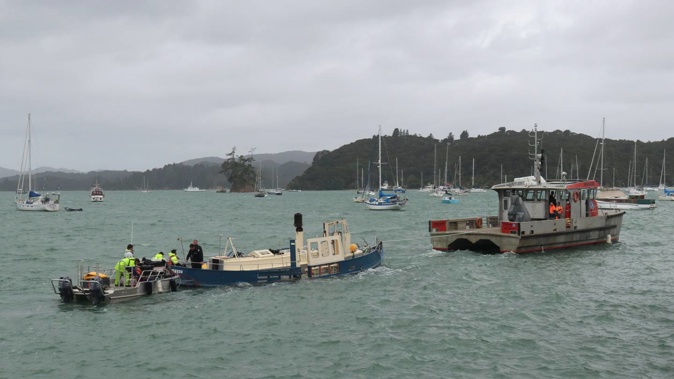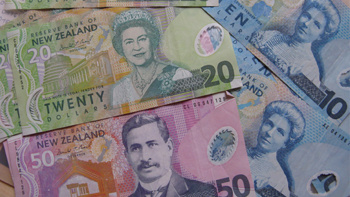
A historic wooden ferry has made a sad, final journey across the Bay of Islands after sinking in a collision involving a high-speed powerboat.
The 79-year-old Waitere, popularly known as the Blue Ferry, sank last Thursday about two hours after the crash that left skipper and owner Bill Elliott, 77, critically injured.
A spokesperson for the family said it would be two to three weeks before any new updates were available regarding Elliott’s condition.
The skipper, who suffered severe head and spinal injuries, underwent surgery on Friday.
At the time of the collision, the ferry was crowded with school holiday visitors but, remarkably, no one else was hurt.
The wreck was salvaged on Saturday after a two-day effort from a depth of about 6-8m midway between Russell and Paihia.
Commercial divers used flotation bags to raise the vessel, which was then towed to Ōpua and hauled from the water using a travel lift.
The painstaking process of pumping out the vessel and raising it, centimetre by centimetre, took several hours.
Northland harbourmaster Jim Lyle said Friday’s first salvage attempt was complicated when the wreck rolled.
With daylight running out it was left on the bottom for another night before it was successfully raised on Saturday afternoon.
- ‘An iconic Russell character’: Community devastated by skipper’s injuries, loss of historic ferry
- 'Bomb site': Witnesses of Bay of Islands boat collision describe horror watching it unfold
- 'A hell of a bang': Passenger ferry sinks in Bay of Islands after collision with launch, skipper critically hurt
Originally it was to have been towed to shore by the divers’ boat but with winds of 20-25 knots buffeting the Bay, the harbourmaster’s vessel had to be called in to help.
Investigators from Maritime NZ and the Transport Accident Investigation Commission (TAIC) were on hand as the vessel arrived about 3pm.
Lyle said the ferry had only limited fuel on board so there were no major pollution concerns.
Old wooden boats with small diesel engines carried relatively small amounts of fuel, unlike modern launches, he said.
/cloudfront-ap-southeast-2.images.arcpublishing.com/nzme/NZOG67TJ2NCUBIULCYRFCDRWVA.jpg)
The refloated wreck of the Waitere under tow to Ōpua with a dive boat following closely behind. Photo / Peter de Graaf
People gathered along the shore to watch the sorry procession as the Waitere made its way to Ōpua at 2 knots, equivalent to a slow walk.
They included boaties, long-time ferry users, and a Far North man who had carried out safety surveys of the vessel for many years.
The man, who did not want to give his name, was staggered by the damage and said the impact had occurred at the strongest point of the solid, well-built boat.
“It was built like a brick s***house,” he said.
/cloudfront-ap-southeast-2.images.arcpublishing.com/nzme/OWC2HMU25RAKHDAEJK5QLQJLLI.jpg)
The damage to the Waitere’s port side is clearly visible. Photo / Peter de Graaf
The Waitere was built in Picton in 1944 to take passengers between Tauranga and Mt Maunganui. It went to Auckland and finally the Bay of Islands after Tauranga’s harbour bridge opened in 1988.
The other boat is also on dry land at an Ōpua boatyard and under a protection order issued by TAIC.
The US-built Boston Whaler 305 Conquest sportfishing boat, with twin Mercury 300-horsepower outboards, is registered with the Royal New Zealand Yacht Squadron in Auckland.
A Florida state maritime registration sticker suggests it was originally used in the US and imported second-hand to New Zealand.
In the USA this model of Boston Whaler is typically listed second-hand on boat sales websites for US$130,000-US$150,000 ($210,000-$240,000).
Boston Whalers are famous for their sturdy construction. When fitted with 300-horsepower outboards the 305 Conquest is said to be capable of almost 50 knots (90km/h).
/cloudfront-ap-southeast-2.images.arcpublishing.com/nzme/IKH2VFMYRFEPLIXA6QDIPMOQRM.jpg)
The Waitere is guided into the travel lift at Bay of Islands Boatyard. Photo / Peter de Graaf
Take your Radio, Podcasts and Music with you









